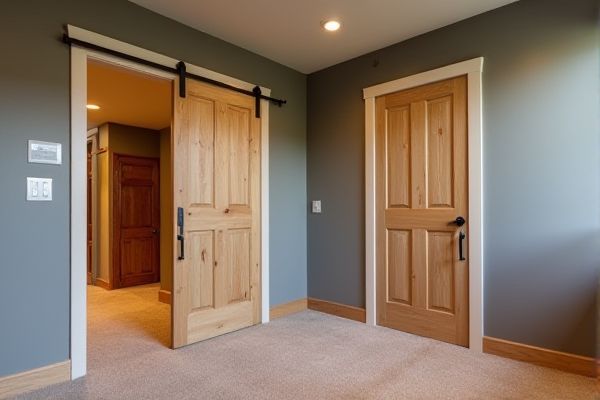
Barn doors add a rustic charm and are easy to install, while pocket doors save space by sliding into the wall, making them ideal for tight basement areas. Explore the rest of this article to determine which door style best fits your basement design and functionality needs.
Table of Comparison
| Feature | Barn Door | Pocket Door |
|---|---|---|
| Space Efficiency | Requires wall space for sliding | Hidden inside the wall, saves floor space |
| Installation Complexity | Simple to moderate | Complex, requires wall modification |
| Cost | Affordable to mid-range | Higher due to structural work |
| Maintenance | Low, easy access | Moderate, access may be limited |
| Durability | High with quality hardware | High but depends on wall integrity |
| Basement Suitability | Ideal for rustic or modern styles | Best for minimalistic, space-saving designs |
Introduction: Choosing the Right Basement Door
Selecting the ideal basement door involves evaluating space efficiency and aesthetic appeal, where barn doors save floor space with their sliding mechanism and offer a rustic charm, while pocket doors provide a seamless look by sliding into the wall cavity. Both door types enhance accessibility and design flexibility, but pocket doors require professional installation due to wall modifications, whereas barn doors offer easier DIY setup. Homeowners should consider room layout, budget, and maintenance preferences to determine the best fit for their basement renovation.
Barn Door vs Pocket Door: Key Differences
Barn doors slide along an exterior track mounted on the wall, making them visually prominent and adding rustic charm, while pocket doors slide into the wall cavity, saving space and maintaining a clean, minimalist look. Barn doors require wall clearance for the sliding track, which may limit furniture placement, whereas pocket doors eliminate this constraint by disappearing entirely when open. Installation complexity differs; pocket doors often involve more structural modifications, including opening up the wall, whereas barn doors generally have a simpler surface-mounted installation.
Space Efficiency: Which Door Saves More Room?
Pocket doors provide superior space efficiency for basements by sliding directly into the wall cavity, eliminating the need for door swing clearance. Barn doors, while visually appealing and relatively compact, require wall space alongside the doorway for sliding, which can limit furniture placement and movement. Therefore, pocket doors save more room in tight basement layouts where maximizing usable floor area is essential.
Installation Process: Barn Door vs Pocket Door
The installation process for barn doors in basements is generally quicker and less invasive, as they mount on the wall surface, requiring only a sturdy header for the sliding track and minimal drywall modifications. Pocket doors necessitate framing out a cavity inside the basement wall to house the door panel, demanding more extensive carpentry, potential electrical or plumbing relocation, and precise measurements to ensure smooth operation. You should consider the structural implications and space availability in your basement before choosing between the easier barn door installation or the more complex, concealed pocket door setup.
Cost Comparison: Budget Implications
Barn doors typically cost between $300 and $1,200, making them a budget-friendly option for basement renovations due to lower installation expenses. Pocket doors, however, range from $600 to $2,500 because of the complex framing and drywall work required, increasing labor and material costs. Choosing barn doors can significantly reduce overall project expenses, especially in budget-conscious basement remodels.
Aesthetic Appeal: Style and Design Options
Barn doors offer a rustic, farmhouse charm with a variety of wood finishes and hardware styles that suit traditional and modern basement designs. Pocket doors create a sleek, minimalist aesthetic by seamlessly disappearing into the wall, maximizing space and providing a clean, contemporary look. Your choice depends on whether you prefer a statement piece that adds character or a subtle door solution that enhances spatial efficiency.
Soundproofing and Privacy Considerations
Barn doors offer limited soundproofing due to gaps between the door and wall, making them less ideal for privacy in a basement setting. Pocket doors slide into the wall cavity, creating a tighter seal that enhances sound insulation and privacy for your basement space. Choosing a pocket door is more effective if noise reduction and confidentiality are top priorities.
Durability and Maintenance Needs
Barn doors feature sturdy hardware and are typically made from durable wood or metal, offering long-lasting performance with minimal maintenance in your basement. Pocket doors, while space-saving and sleek, often require more upkeep due to the intricate sliding mechanism hidden inside the wall, which can accumulate dust and demand occasional repairs. Choosing between these options depends on your preference for durability versus low visibility in your basement design.
Accessibility and Ease of Use
Barn doors provide easier accessibility in basements due to their sliding mechanism that moves along the wall, requiring minimal floor space and allowing for quick, wide openings. Pocket doors slide into the wall cavity, saving space but may pose challenges for ease of use if the wall frame limits door size or if tracks become obstructed. Choosing between barn and pocket doors depends on balancing accessibility needs with available wall space and maintenance considerations.
Final Verdict: Best Door for Your Basement
Barn doors provide a rustic aesthetic and save floor space with their sliding mechanism, making them ideal for basement areas with limited room. Pocket doors offer a sleek, concealed option that maximizes space efficiency and creates a seamless look, perfect for modern basement designs. Consider the basement's layout and style preferences; barn doors suit open, decorative spaces while pocket doors excel in compact, minimalist environments.
 homyna.com
homyna.com